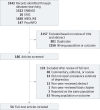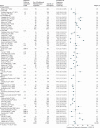Prevalence of Depression and Depressive Symptoms Among Resident Physicians: A Systematic Review and Meta-analysis
- PMID: 26647259
- PMCID: PMC4866499
- DOI: 10.1001/jama.2015.15845
Prevalence of Depression and Depressive Symptoms Among Resident Physicians: A Systematic Review and Meta-analysis
Abstract
Importance: Physicians in training are at high risk for depression. However, the estimated prevalence of this disorder varies substantially between studies.
Objective: To provide a summary estimate of depression or depressive symptom prevalence among resident physicians.
Data sources and study selection: Systematic search of EMBASE, ERIC, MEDLINE, and PsycINFO for studies with information on the prevalence of depression or depressive symptoms among resident physicians published between January 1963 and September 2015. Studies were eligible for inclusion if they were published in the peer-reviewed literature and used a validated method to assess for depression or depressive symptoms.
Data extraction and synthesis: Information on study characteristics and depression or depressive symptom prevalence was extracted independently by 2 trained investigators. Estimates were pooled using random-effects meta-analysis. Differences by study-level characteristics were estimated using meta-regression.
Main outcomes and measures: Point or period prevalence of depression or depressive symptoms as assessed by structured interview or validated questionnaire.
Results: Data were extracted from 31 cross-sectional studies (9447 individuals) and 23 longitudinal studies (8113 individuals). Three studies used clinical interviews and 51 used self-report instruments. The overall pooled prevalence of depression or depressive symptoms was 28.8% (4969/17,560 individuals, 95% CI, 25.3%-32.5%), with high between-study heterogeneity (Q = 1247, τ2 = 0.39, I2 = 95.8%, P < .001). Prevalence estimates ranged from 20.9% for the 9-item Patient Health Questionnaire with a cutoff of 10 or more (741/3577 individuals, 95% CI, 17.5%-24.7%, Q = 14.4, τ2 = 0.04, I2 = 79.2%) to 43.2% for the 2-item PRIME-MD (1349/2891 individuals, 95% CI, 37.6%-49.0%, Q = 45.6, τ2 = 0.09, I2 = 84.6%). There was an increased prevalence with increasing calendar year (slope = 0.5% increase per year, adjusted for assessment modality; 95% CI, 0.03%-0.9%, P = .04). In a secondary analysis of 7 longitudinal studies, the median absolute increase in depressive symptoms with the onset of residency training was 15.8% (range, 0.3%-26.3%; relative risk, 4.5). No statistically significant differences were observed between cross-sectional vs longitudinal studies, studies of only interns vs only upper-level residents, or studies of nonsurgical vs both nonsurgical and surgical residents.
Conclusions and relevance: In this systematic review, the summary estimate of the prevalence of depression or depressive symptoms among resident physicians was 28.8%, ranging from 20.9% to 43.2% depending on the instrument used, and increased with calendar year. Further research is needed to identify effective strategies for preventing and treating depression among physicians in training.
Figures





Comment in
-
Resident Depression: The Tip of a Graduate Medical Education Iceberg.JAMA. 2015 Dec 8;314(22):2357-8. doi: 10.1001/jama.2015.15408. JAMA. 2015. PMID: 26647255 No abstract available.
-
High prevalence of depression in medical residents: the sad reality of medical training.Evid Based Med. 2016 Jun;21(3):118. doi: 10.1136/ebmed-2016-110381. Epub 2016 Mar 3. Evid Based Med. 2016. PMID: 26940711 No abstract available.
-
Resident Physicians With Depression or Depressive Symptoms.JAMA. 2016 Jun 7;315(21):2347. doi: 10.1001/jama.2016.1716. JAMA. 2016. PMID: 27272588 No abstract available.
-
Resident Physicians With Depression or Depressive Symptoms--In Reply.JAMA. 2016 Jun 7;315(21):2347-8. doi: 10.1001/jama.2016.1724. JAMA. 2016. PMID: 27272589 No abstract available.
References
-
- Schneider SE, Phillips WM. Depression and anxiety in medical, surgical, and pediatric interns. Psychol Rep. 1993;72(3 pt 2):1145–1146. - PubMed
-
- Kessler RC, Berglund P, Demler O, Jin R, Merikangas KR, Walters EE. Lifetime prevalence and age-of-onset distributions of DSM-IV disorders in the National Comorbidity Survey Replication. Arch Gen Psychiatry. 2005;62(6):593–602. - PubMed
-
- Dyrbye LN, Thomas MR, Shanafelt TD. Systematic review of depression, anxiety, and other indicators of psychological distress among US and Canadian medical students. Acad Med. 2006;81(4):354–373. - PubMed
-
- Joules N, Williams DM, Thompson AW. Depression in resident physicians: a systematic review. Open J Depress. 2014;03(03):89–100.
Publication types
MeSH terms
Grants and funding
LinkOut - more resources
Full Text Sources
Other Literature Sources
Medical

